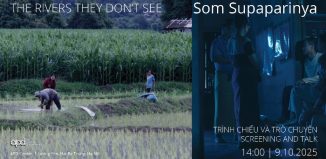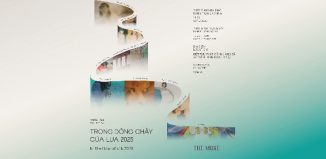Talk with Senior Curator Tran Luong at Singapore Biennale 2013
The Loofah Trellis, 2011
In Vietnam, “loofah” is street slang for lactating mothers or women past middle age. Nguyen is a young mother herself, and central to her practice is an interrogation of the female body and form in the context of patriarchal societies. This work speaks from a position of protest against derogatory attitudes directed at the objectification of women’s bodies. The ‘breasts’ incorporated in the growing green trellises allude to the organic form that fruits have, further highlighting – in a tongue-in-cheek manner – the means by which the female form is objectified and subjected to the gaze of others.
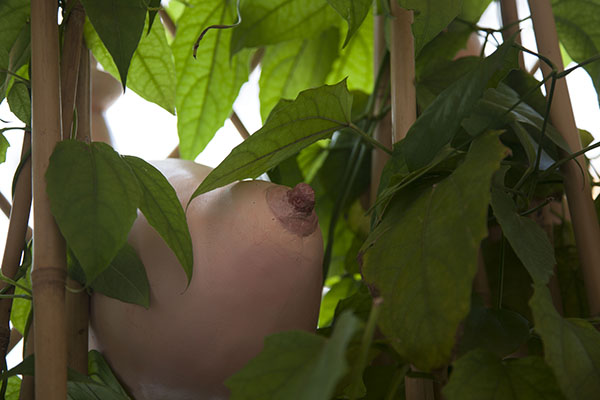
Silicon, composite plastic and fibreglass
Dimensions: Variable
Photo courtersy of Nguyen Ngoc Khanh
Nguyen Trinh Thi
Born in 1973, Nguyen Trinh Thi is a Hanoi-based independent filmmaker and video artist and is the founder and director of DOCLAB, an independent centre for documentary film and video art in Hanoi. Her practice is vested in the exploration of memory in order to unveil hidden, displaced or misinterpreted histories as well as an in-depth examination of the position and role of artists in Vietnamese society today. Select exhibitions include Women in Between: Asian Women Artists 1984-2012, Fukuoka Asia Art Museum, Okinawa Prefectural Art Museum, Tochigi Prefecture Art Museum of Fine Arts, Mie Prefectural Art Museum, Japan (2012); The City in Art, Goethe Institut, Hanoi (2010); No Soul for Sale 2, Tate Modern, London (2012).
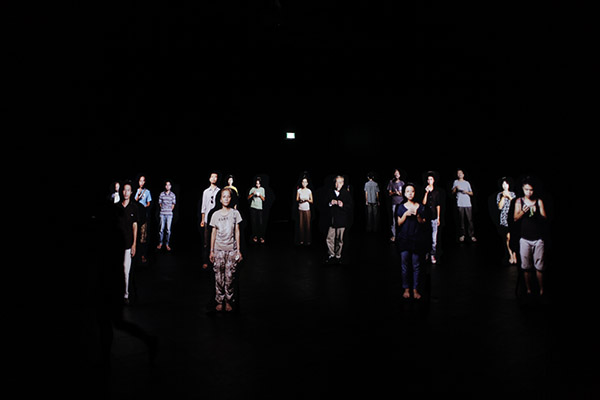
Video projection on wooden cut-outs
Dimensions variable
Photo Credit: Jamie Maxtone-Graham
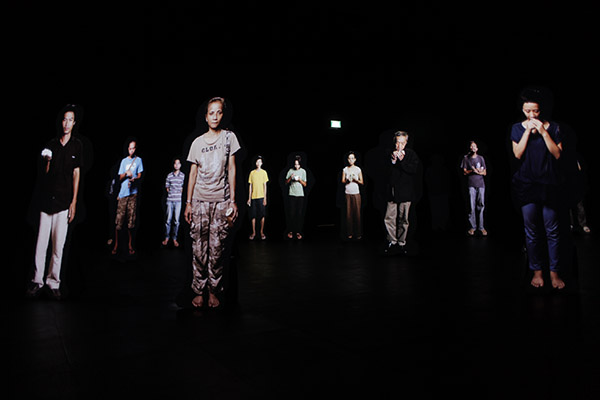
Video projection on wooden cut-outs
Dimensions variable
Photo Credit: Jamie Maxtone-Graham
Unsubtitled, 2010
Nguyen issues a call to arms to a community of artists and cultural workers, in a performance which uses the act of eating as a metaphor to interrogate the artist’s right to freedom of expression and peaceful existence. The act of eating is universal and deceptively simple, a knee-jerk reaction to survival that is relatable across all sociocultural boundaries. Yet it is also nonconformist: individuals are free to choose the food they desire, as well as their emotional responses to their food. Here, the haunting echoes of chewing and swallowing reverberate through the wooden cut-outs, adding a coded layer of interpretation to the act of eating. The terse and tentative manner in which food is consumed also highlights the artificiality of a community under surveillance.
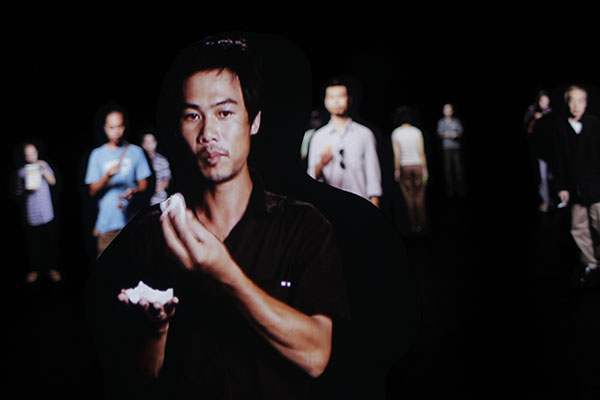
Video projection on wooden cut-outs
Dimensions variable
Photo Credit: Jamie Maxtone-Graham
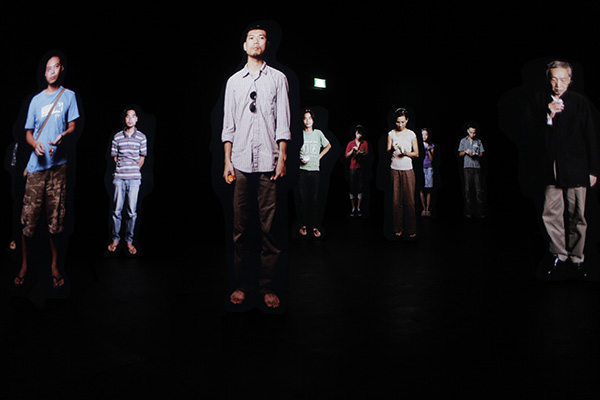
Video projection on wooden cut-outs
Dimensions variable
Photo Credit: Jamie Maxtone-Graham
Outside is Uu Dam Tran Nguyen’s video projection, a Viet Kieu artist.
Uu Dam Tran Nguyen
Born in Vietnam in 1971, Uu Dam Tran Nguyen lives in Ho Chi Minh City, Vietnam and LA, California. He studied at the University of Fine Arts, Saigon, Vietnam and later earned his BA at the University of California, Los Angeles, CA and MFA and the School of Visual Arts, New York, NY. Nguyen’s transnational experiences are reflected in his rich body of work that includes choreographed performance video, sculpture, drawing, drone painting and installation. Nguyen is a visual spokesman for several contemporary topics that inspire him from the ranks of religion to sexuality, power, identity politics, war technology and the Internet. Selected exhibitions include Poetic Politic, Kadist Art Foundation, San Francisco (2012); Portrait of Mr. Alex Tuan Dinh Pham, CA Art Foundation, California State University Dominguez Hills (2011); “Honey…”, Howl Festival, New York (2009).

Single-channel video
Duration 3:00 mins
Artist Collection
Photo Courtesy of Nguyen Ngoc Khanh
Waltz of the Machine Equestrians – The Machine Equestrians, 2012
This work was inspired by the movement of traffic in Ho Chi Minh City. Nguyen uses raincoats, clips and rubber bands to connect 28 scooter riders into what appears to be a choreographed ‘scooter dance’. Seen either as a group of moving tents of a contemporary nomadic tribe, or a test of tensions between an individual and its collective, the streets are transformed into a stage for the scooter riders. The artist re-imagines a heroic celebration of modernity, where rural land was paved for urban roads and the convenience of motorised transport. The climax, however, occurs when the collective breaks free from their binding structures. This conveys a certain ambivalence towards the present, and the anticipation for a different kind of change in the future.
Lam Hieu Thuan
Born in 1973 and lives in Ho Chi Minh City, Vietnam, Lam Hieu Thuan is a documentary photographer. His works touch upon social, cultural and political gaps between the past and the present.
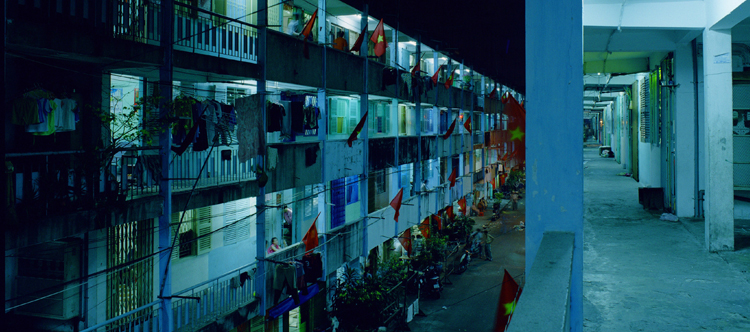
2004 – 2006
Single-channel video
Dimensions: 2:38 mins
Photo Courtesy of artist, taking from Singapore Biennale website
This work features a communal living complex in Ho Chi Minh City. It was erected in the 1960s by Nguyen Tan Doi, the “king of building”, and before 1975, it was referred to as the President Building as the 13-storey structure was the highest in the city. It was at first leased to American soldiers and after April 1975, it became the home of government officials. There are now plans for the building to be demolished and its residents are again faced with an uncertain future. Lam’s close-up footage of eerily lit corridors focuses on the communal spaces which connect one household to another. The single-perspective lens also prompts investigation into the labyrinth of networks and interconnected histories that bind this community together.
Driven by promoting South East Asia contemporary arts – “If the world changed”, the four edition questions participating artists to reconsider the world they are living in and want to live in.
The exhibition is on from 26 Oct 2013 – 16 Feb 2014 at Bras Basah – Bugis Precinct, Singapore (Singapore Art Museum, 8Q SAM, National Museum Singapore, National Library)
* All information about Vietnamese artists and art works are introduced in Singapore Biennale 2013 official website.
Reported by Tran Thi Minh Hue from Singapore Biennale 2013.


